Northstar EXPLORER 650 Installation Guide
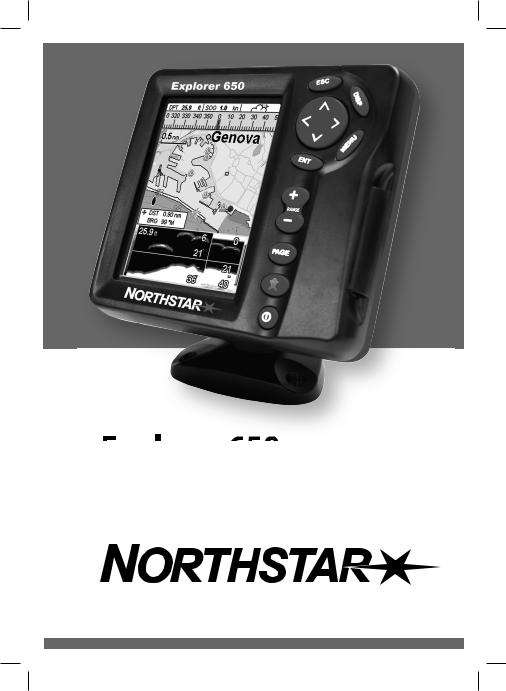
Explorer 650
Chartplotter and Fishfinder
Installation and Operation Manual
www.northstarnav.com
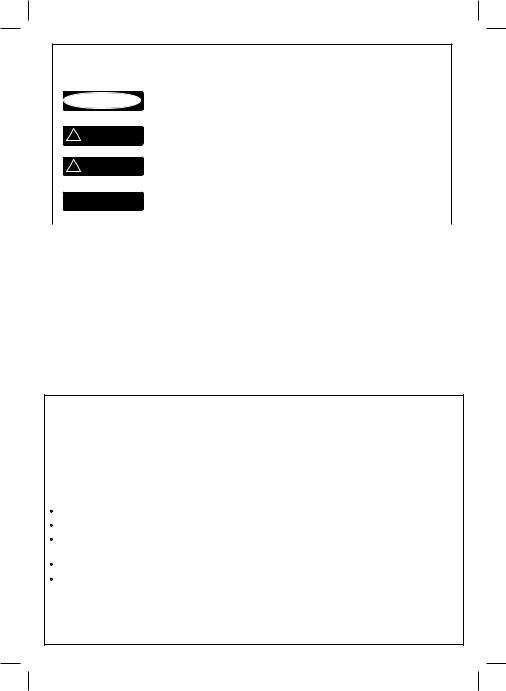
IMPORTANT SAFETY INFORMATION
Please read carefully before installation and use.
|
|
This is the safety alert symbol. It is used to alert you to potential |
|
DANGER |
personal injury hazards, Obey all safety messages that follow this symbol to |
||
|
|
avoid possible injury or death. |
|
|
|
|
|
! |
WARNING |
WARNING indicates a potentially hazardous situation which, if not avoided, |
|
could result in death or serious injury |
|||
|
|
|
|
! |
CAUTION |
CAUTION indicates a potentially hazardous situation which, if not avoided, could |
|
|
|
result in minor or moderate injury. |
|
|
|
|
|
CAUTION |
CAUTION used without the safety alert symbol indicates a potentially |
||
hazardous situation which, if not avoided, may result in property damage. |
|||
|
|
||
|
|
|
|
DISCLAIMER: It is the owner’s sole responsibility to install and use the instrument and transducers in a manner that will not cause accidents, personal injury or property damage. The user of this product is solely responsible for observing safe boating practices.
BRUNSWICK NEW TECHNOLOGIES INC. AND ITS SUBSIDIARIES AND AFFILIATES DISCLAIM ALL LIABILITY FOR ANY USE OF THIS PRODUCT IN A WAY THAT MAY CAUSE ACCIDENTS, DAMAGE OR THAT MAY VIOLATE THE LAW.
Governing Language: This statement, any instruction manuals, user guides and other information relating
to the product (Documentation) may be translated to, or has been translated from, another language (Translation). In the event of any conflict between any Translation of the Documentation, the English language version of the Documentation will be the official version of the Documentation.
This manual represents the Explorer 650 as at the time of printing. Brunswick New Technologies Inc. and its subsidiaries and affiliates reserve the right to make changes to specifications without notice.
Copyright © 2006 Brunswick New Technologies Inc. Northstar™ is a registered trademark of Brunswick New Technologies Inc
FCC Statement
Note: This equipment has been tested and found to comply with the limits for a Class B digital device, pursuant to Part 15 of the FCC Rules. These limits are designed to provide reasonable protection against harmful interference in a normal installation. This equipment generates, uses and can radiate radio frequency energy and, if not installed and used in accordance with the instructions, may cause harmful interference to radio communications. However, there is no guarantee that interference will not occur in a particular installation. If this equipment does cause harmful interference to radio or television reception,
which can be determined by turning the equipment off and on, the user is encouraged to try to correct the interference by one or more of the following measures:
Reorient or relocate the receiving antenna.
Increase the separation between the equipment and receiver.
Connect the equipment into an output on a circuit different from that to which the receiver is connected.
Consult the dealer or an experienced technician for help.
A shielded cable must be used when connecting a peripheral to the serial ports.
Industry Canada
Operation is subject to the following two conditions: (1) this device may not cause interference, and (2) this device must accept any interference, including interference that may cause undesired operation of the device.

Contents
1 Introduction ......................................................................................................................................... |
7 |
1-1 Overview . . . . . . . . . . . . . . . . . . . . . . . . . . . . . . . . . . . . . . . . . . . . . . . . . . . . . . . . . . . . . . . . . . . . . . . . . 8 1-2 Cleaning and maintenance . . . . . . . . . . . . . . . . . . . . . . . . . . . . . . . . . . . . . . . . . . . . . . . . . . . . . . . 8 1-3 Plug-in cards . . . . . . . . . . . . . . . . . . . . . . . . . . . . . . . . . . . . . . . . . . . . . . . . . . . . . . . . . . . . . . . . . . . . . 8 1-4 Removing and replacing the display unit . . . . . . . . . . . . . . . . . . . . . . . . . . . . . . . . . . . . . . . . . 9
2 Basic Operation.................................................................................................................................... |
10 |
2-1 Using the keys . . . . . . . . . . . . . . . . . . . . . . . . . . . . . . . . . . . . . . . . . . . . . . . . . . . . . . . . . . . . . . . . . . . 10 2-2 Turning on and off / auto power . . . . . . . . . . . . . . . . . . . . . . . . . . . . . . . . . . . . . . . . . . . . . . . . . 11 2-3 Backlight and night mode . . . . . . . . . . . . . . . . . . . . . . . . . . . . . . . . . . . . . . . . . . . . . . . . . . . . . . . 12 2-4 Man overboard (MOB). . . . . . . . . . . . . . . . . . . . . . . . . . . . . . . . . . . . . . . . . . . . . . . . . . . . . . . . . . . 12 2-5 Alarms. . . . . . . . . . . . . . . . . . . . . . . . . . . . . . . . . . . . . . . . . . . . . . . . . . . . . . . . . . . . . . . . . . . . . . . . . . . 13 2-6 Simulate mode . . . . . . . . . . . . . . . . . . . . . . . . . . . . . . . . . . . . . . . . . . . . . . . . . . . . . . . . . . . . . . . . . . 13 2-7 The main displays . . . . . . . . . . . . . . . . . . . . . . . . . . . . . . . . . . . . . . . . . . . . . . . . . . . . . . . . . . . . . . . 14
3 Navigation: Chart................................................................................................................................. |
18 |
3-1 Introduction to navigating. . . . . . . . . . . . . . . . . . . . . . . . . . . . . . . . . . . . . . . . . . . . . . . . . . . . . . . 18 3-2 Chart display . . . . . . . . . . . . . . . . . . . . . . . . . . . . . . . . . . . . . . . . . . . . . . . . . . . . . . . . . . . . . . . . . . . . 21 3-3 Distance and bearing calculator . . . . . . . . . . . . . . . . . . . . . . . . . . . . . . . . . . . . . . . . . . . . . . . . .23 3-4 Projected course . . . . . . . . . . . . . . . . . . . . . . . . . . . . . . . . . . . . . . . . . . . . . . . . . . . . . . . . . . . . . . . .23 3-5 Tracks and tracking. . . . . . . . . . . . . . . . . . . . . . . . . . . . . . . . . . . . . . . . . . . . . . . . . . . . . . . . . . . . . .24
4 Navigation: Highway display................................................................................................................ |
24 |
5 Navigation: Waypoints......................................................................................................................... |
25 |
5-1 Waypoints display . . . . . . . . . . . . . . . . . . . . . . . . . . . . . . . . . . . . . . . . . . . . . . . . . . . . . . . . . . . . . . . |
25 |
5-2 Managing waypoints . . . . . . . . . . . . . . . . . . . . . . . . . . . . . . . . . . . . . . . . . . . . . . . . . . . . . . . . . . . . |
26 |
6 Navigation: Routes .............................................................................................................................. |
27 |
6-1 Routes display. . . . . . . . . . . . . . . . . . . . . . . . . . . . . . . . . . . . . . . . . . . . . . . . . . . . . . . . . . . . . . . . . . . |
27 |
6-2 Managing routes . . . . . . . . . . . . . . . . . . . . . . . . . . . . . . . . . . . . . . . . . . . . . . . . . . . . . . . . . . . . . . . . |
28 |
7 Satellites ............................................................................................................................................. |
30 |
7-1 Satellite display . . . . . . . . . . . . . . . . . . . . . . . . . . . . . . . . . . . . . . . . . . . . . . . . . . . . . . . . . . . . . . . . . . |
31 |
8 Sonar fishfinding: Introduction ........................................................................................................... |
31 |
8-1 Using the Explorer 650 . . . . . . . . . . . . . . . . . . . . . . . . . . . . . . . . . . . . . . . . . . . . . . . . . . . . . . . . . . 31 8-2 Interpreting the display. . . . . . . . . . . . . . . . . . . . . . . . . . . . . . . . . . . . . . . . . . . . . . . . . . . . . . . . . .32 8-3 Single and Dual frequency fishfinding. . . . . . . . . . . . . . . . . . . . . . . . . . . . . . . . . . . . . . . . . . .34

8-4 Fish detection and display. . . . . . . . . . . . . . . . . . . . . . . . . . . . . . . . . . . . . . . . . . . . . . . . . . . . . . .37 8-5 Range . . . . . . . . . . . . . . . . . . . . . . . . . . . . . . . . . . . . . . . . . . . . . . . . . . . . . . . . . . . . . . . . . . . . . . . . . . .38 8-6 Gain and threshold. . . . . . . . . . . . . . . . . . . . . . . . . . . . . . . . . . . . . . . . . . . . . . . . . . . . . . . . . . . . . .39
9 Sonar fishfinding: Displays .................................................................................................................. |
40 |
9-1 Sonar history display - no split . . . . . . . . . . . . . . . . . . . . . . . . . . . . . . . . . . . . . . . . . . . . . . . . . .40 9-2 Sonar Zoom display . . . . . . . . . . . . . . . . . . . . . . . . . . . . . . . . . . . . . . . . . . . . . . . . . . . . . . . . . . . . . 41 9-3 Sonar Bottom display. . . . . . . . . . . . . . . . . . . . . . . . . . . . . . . . . . . . . . . . . . . . . . . . . . . . . . . . . . . . 41 9-4 Sonar 50/200 display . . . . . . . . . . . . . . . . . . . . . . . . . . . . . . . . . . . . . . . . . . . . . . . . . . . . . . . . . . . .42 9-5 Sonar A-Scope display . . . . . . . . . . . . . . . . . . . . . . . . . . . . . . . . . . . . . . . . . . . . . . . . . . . . . . . . . .42
10 Gauges display ................................................................................................................................... |
44 |
11 Data display ....................................................................................................................................... |
45 |
12 Fuel functions and display.................................................................................................................. |
46 |
12-1 When you add or remove fuel . . . . . . . . . . . . . . . . . . . . . . . . . . . . . . . . . . . . . . . . . . . . . . . . . .46 12-2 Fuel display . . . . . . . . . . . . . . . . . . . . . . . . . . . . . . . . . . . . . . . . . . . . . . . . . . . . . . . . . . . . . . . . . . . .47 12-3 Fuel consumption curves . . . . . . . . . . . . . . . . . . . . . . . . . . . . . . . . . . . . . . . . . . . . . . . . . . . . . .48
13 Tides display ...................................................................................................................................... |
50 |
14 User card display ................................................................................................................................ |
51 |
15 DSC/Buddy track displays ................................................................................................................... |
52 |
15-1 The displays . . . . . . . . . . . . . . . . . . . . . . . . . . . . . . . . . . . . . . . . . . . . . . . . . . . . . . . . . . . . . . . . . . . . |
53 |
15-2 Using the displays . . . . . . . . . . . . . . . . . . . . . . . . . . . . . . . . . . . . . . . . . . . . . . . . . . . . . . . . . . . . . . |
54 |
16 About display..................................................................................................................................... |
55 |
17 Setting up the Explorer 650 ................................................................................................................ |
55 |
17-1 Setup > System . . . . . . . . . . . . . . . . . . . . . . . . . . . . . . . . . . . . . . . . . . . . . . . . . . . . . . . . . . . . . . . .57
17-2 Setup > Chart . . . . . . . . . . . . . . . . . . . . . . . . . . . . . . . . . . . . . . . . . . . . . . . . . . . . . . . . . . . . . . . . . .58
17-3 Setup > Sonar . . . . . . . . . . . . . . . . . . . . . . . . . . . . . . . . . . . . . . . . . . . . . . . . . . . . . . . . . . . . . . . . . . 61
17-4 Setup > GPS . . . . . . . . . . . . . . . . . . . . . . . . . . . . . . . . . . . . . . . . . . . . . . . . . . . . . . . . . . . . . . . . . . .62
17-5 Setup > Fuel . . . . . . . . . . . . . . . . . . . . . . . . . . . . . . . . . . . . . . . . . . . . . . . . . . . . . . . . . . . . . . . . . . .62
17-6 Setup > Track. . . . . . . . . . . . . . . . . . . . . . . . . . . . . . . . . . . . . . . . . . . . . . . . . . . . . . . . . . . . . . . . . . .64
17-7 Setup > Logs . . . . . . . . . . . . . . . . . . . . . . . . . . . . . . . . . . . . . . . . . . . . . . . . . . . . . . . . . . . . . . . . . . .65
17-8 Setup > Alarms . . . . . . . . . . . . . . . . . . . . . . . . . . . . . . . . . . . . . . . . . . . . . . . . . . . . . . . . . . . . . . . . .65
17-9 Setup > Units. . . . . . . . . . . . . . . . . . . . . . . . . . . . . . . . . . . . . . . . . . . . . . . . . . . . . . . . . . . . . . . . . . .66
17-10 Setup > Comms . . . . . . . . . . . . . . . . . . . . . . . . . . . . . . . . . . . . . . . . . . . . . . . . . . . . . . . . . . . . . . .67
17-11 Setup > Calibrate . . . . . . . . . . . . . . . . . . . . . . . . . . . . . . . . . . . . . . . . . . . . . . . . . . . . . . . . . . . . . .68

17-12 Setup > Time . . . . . . . . . . . . . . . . . . . . . . . . . . . . . . . . . . . . . . . . . . . . . . . . . . . . . . . . . . . . . . . . .69
17-13 Setup > Favorites . . . . . . . . . . . . . . . . . . . . . . . . . . . . . . . . . . . . . . . . . . . . . . . . . . . . . . . . . . . . .69
17-14 Setup > Simulate . . . . . . . . . . . . . . . . . . . . . . . . . . . . . . . . . . . . . . . . . . . . . . . . . . . . . . . . . . . . .70
18 Installation ....................................................................................................................................... |
71 |
18-1 What comes with the Explorer 650 . . . . . . . . . . . . . . . . . . . . . . . . . . . . . . . . . . . . . . . . . . . . .71 18-2 Options and Accessories . . . . . . . . . . . . . . . . . . . . . . . . . . . . . . . . . . . . . . . . . . . . . . . . . . . . . . .71 18-3 The display unit . . . . . . . . . . . . . . . . . . . . . . . . . . . . . . . . . . . . . . . . . . . . . . . . . . . . . . . . . . . . . . . .73 18-4 Power/data cable . . . . . . . . . . . . . . . . . . . . . . . . . . . . . . . . . . . . . . . . . . . . . . . . . . . . . . . . . . . . . . 74 18-5 GPS antenna . . . . . . . . . . . . . . . . . . . . . . . . . . . . . . . . . . . . . . . . . . . . . . . . . . . . . . . . . . . . . . . . . . .75 18-6 Sonar transducer. . . . . . . . . . . . . . . . . . . . . . . . . . . . . . . . . . . . . . . . . . . . . . . . . . . . . . . . . . . . . . .75 18-7 Northstar petrol/gasoline sensors . . . . . . . . . . . . . . . . . . . . . . . . . . . . . . . . . . . . . . . . . . . . . . 76 18-8 DSC VHF radio . . . . . . . . . . . . . . . . . . . . . . . . . . . . . . . . . . . . . . . . . . . . . . . . . . . . . . . . . . . . . . . . . 76 18-9 SmartCraft . . . . . . . . . . . . . . . . . . . . . . . . . . . . . . . . . . . . . . . . . . . . . . . . . . . . . . . . . . . . . . . . . . . . .77 18-10 Other NavBus instruments . . . . . . . . . . . . . . . . . . . . . . . . . . . . . . . . . . . . . . . . . . . . . . . . . . . .77 18-11 Other NMEA instruments. . . . . . . . . . . . . . . . . . . . . . . . . . . . . . . . . . . . . . . . . . . . . . . . . . . . . .78 18-12 Setup and test. . . . . . . . . . . . . . . . . . . . . . . . . . . . . . . . . . . . . . . . . . . . . . . . . . . . . . . . . . . . . . . . .78
Appendix A - Specifications..................................................................................................................... |
79 |
Appendix B - Troubleshooting................................................................................................................. |
81 |
B-1 General problems . . . . . . . . . . . . . . . . . . . . . . . . . . . . . . . . . . . . . . . . . . . . . . . . . . . . . . . . . . . . . . . 81 B-2 GPS navigation problems. . . . . . . . . . . . . . . . . . . . . . . . . . . . . . . . . . . . . . . . . . . . . . . . . . . . . . . .82 B-3 Fuel consumption problems. . . . . . . . . . . . . . . . . . . . . . . . . . . . . . . . . . . . . . . . . . . . . . . . . . . . .82 B-4 Sonar fishfinding problems . . . . . . . . . . . . . . . . . . . . . . . . . . . . . . . . . . . . . . . . . . . . . . . . . . . . .83
Appendix C - Glossary and navigation data.............................................................................................. |
85 |

Important
It is the owner’s sole responsibility to install and use the instrument in a manner that will not cause accidents, personal injury or property damage. The user of this product is solely responsible for observing safe boating practices.
Global Positioning System: The Global Positioning System (GPS) is operated by the US Government which is solely responsible for its operation, accuracy and maintenance. The GPS system is subject to changes which could affect the accuracy and performance of all GPS equipment anywhere in the world including the Explorer. Whilst the Northstar Explorer is a precision navigation instrument, it can be misused or misinterpreted, which can result in its use being unsafe. To reduce the risk of misusing or misinterpreting the Explorer, the user must read and understand all aspects of this Installation and Operation manual. We also suggest that the user practice all operations using the built in simulator before using the Explorer at sea.
Electronic Chart: The electronic chart used by the Explorer is an aid to navigation and is designed to supplement the use of official government charts not replace them. Only official government charts supplemented by notices to mariners contain the information required for safe and prudent navigation. Always supplement the information provided by the Explorer with other plotting sources such as observations, depth soundings, radar and hand compass bearings. Should the information not agree then the discrepancy must be resolved before proceeding any further.
Sonar fishfinder: The accuracy of the sonar depth display can be limited by many factors, including the type of the transducers, the location of the transducers and water conditions. It is the user’s responsibility to ensure the Explorer transducers are installed and used correctly.
Fuel Computer: Fuel economy can alter drastically depending on the boat loading and sea conditions. The fuel computer should not be the sole source of information concerning available fuel onboard and the electronic information should be supplemented by visual or other checks of the fuel load. This is necessary due to possible operator induced errors such as forgetting to reset the fuel used when filling the tank, running the engine with the fuel computer not switched on or other operator controlled actions that may render the device inaccurate. Always ensure that adequate fuel is carried onboard for the intended trip plus a reserve to allow for unforeseen circumstances.
THIS MANUAL REPRESENTS THE EXPLORER 650 AS AT THE TIME OF PRINTING. NORTHSTAR RESERVES THE RIGHT TO MAKE CHANGES TO SPECIFICATIONS WITHOUT NOTICE.
The Explorer 650 is set up with default units of feet, °F (Fahrenheit), US gallons and knots. To change the units, see section 17-9.
6 |
Northstar Explorer 650 Installation and Operation Manual |

1 Introduction
Quick reference to the built-in and optional features:
Feature |
Type |
See |
Requires |
General |
How to use the keys and displays |
2 |
|
|
Troubleshooting |
Appendix B |
|
|
Simulate mode |
2-6 |
|
|
Glossary of special names |
Appendix C |
|
|
Specifications |
Appendix A |
|
MOB |
Man overboard key |
2-4 |
|
Navigation |
Overview of how to navigate |
3-1 |
GPS fix |
|
Finding the boat’s position on the chart |
3-2 |
|
|
Navigate to any point or to a waypoint |
3-1 |
|
|
Navigate along a route |
3-1 |
|
|
Projected course: An estimate of progress |
3-4 |
|
|
Tracks: records of where the boat has been |
3-5 |
|
|
GPS receiver status |
7 |
|
|
Saving and loading data with a user card |
14 |
User card |
Chart data |
Chart features (built in world chart) |
3-2 |
|
|
Chart details |
3-2-4 & 5 |
C-MAP™ chart |
|
Tides at a port |
13 |
C-MAP™ chart |
Alarms |
Built in alarms |
2-5 |
|
|
SmartCraft engine alarms |
1-1 |
SmartCraft |
Boat data |
Data at top of main displays |
2-7-3 |
|
|
Compass at top of main displays |
2-7-4 |
|
|
Dedicated data display |
11 |
|
Fuel |
Fuel computer, Explorer petrol/gasoline engine |
12 |
Fuel sensors |
|
Fuel computer, SmartCraft engines |
12 |
SmartCraft |
|
What to do when you add or remove fuel |
12-1 |
|
|
|
|
|
Sounder |
Overview of the depth sounder |
8 |
Sounder |
|
Depth, bottom features, water features |
8 |
Sounder |
|
Fishfinder |
8 |
Sounder |
|
|
|
|
Other boats |
Track your buddy, polling other boats |
15 |
DSC VHF |
|
Distress calls |
15 |
DSC VHF |
|
|
|
|
Northstar Explorer 650 Installation and Operation Manual |
7 |

1-1 Overview
The Northstar Explorer 650 is a compact, rugged, highly integrated marine chartplotter and fishfinder. It is easy to use and has an easy to read color display. Complex functions can be
performed with a few key presses, taking the hard work out of boating.
The available functions, displays and setup menus depend on the optional sensors and instruments that are installed:
Sonar functions require a sonar transducer to be installed
Fuel functions require one or more petrol/gasoline to be installed.
SmartCraft engine functions require a SmartCraft system to be installed. For information on using SmartCraft, see the
SmartCraft Gateway Installation and Operation Manual.
DSC/Buddy track functions require a Northstar DSC VHF radio with Buddy track support to be installed.
The Explorer can send data to other instruments, such as an autopilot, and receive data from other instruments.
For information on installing options, see section 18-2.
This manual describes how to install and operate the Explorer. Special terms are explained in Appendix C. For maximum benefit, please read this manual carefully before installing and using the unit. For more information on this instrument and other Northstar products, go to our website, www.northstarnav.com.
1-2 Cleaning and maintenance
The Explorer screen is covered by a proprietary anti-reflection coating. To avoid damage, clean the screen only with a damp cloth and mild detergent when dirty or covered in sea salt. Avoid abrasive cleaners, petrol or other solvents. If a plug-in card gets dirty or wet, clean it with a damp cloth or mild detergent.
Cover or remove a transom-mounted transducer when repainting the hull. If painting over a through hull transducer with antifouling paint,
use only one coat of paint. Remove the previous coat of antifouling paint by sanding it lightly.
To optimize performance, avoid walking on or jamming cables and connectors. Keep the
transducer free of weed, paint and debris. Do not use a high pressure water blast on a speed sensor paddlewheel as it may damage the bearings.
Push the dust cover over the display when the Explorer is turned off.
1-3 Plug-in cards
The Explorer can use two kinds of plug-in card:
C-MAP™ chart cards have chart details required for navigating in a particular region. When a chart card is plugged in, the extra details automatically appear on the Explorer chart display.
The Explorer can use NT, NT+ and NT-MAX cards. NT-MAX cards have much more chart information than earlier cards, including photos of points of interest.
C-MAP™ user cards are used to store navigation data. Each user card expands the Explorer memory and allows the data to be transferred to another Explorer easily (see section 14).
Note: The older 5 volt user cards are not supported.
8 |
Northstar Explorer 650 Installation and Operation Manual |
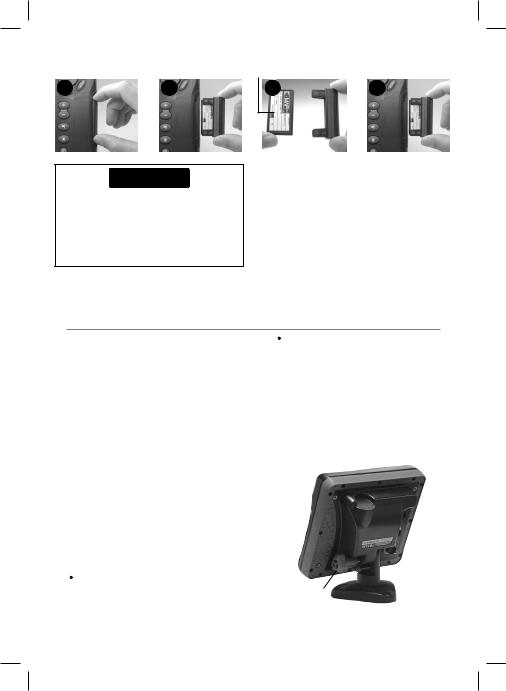
Changing the plug-in card
Gold contacts under here
1 |
2 |
CAUTION
Handle plug-in cards carefully. Keep them in their protective cases when not plugged into the Explorer.
Keep the holder in place in the Explorer at all times to prevent moisture from entering the card compartment.
1-4 Removing and replacing the display unit
3 |
4 |
Card
Holder
Turn the Explorer off (see section 2-2).
Pull the card holder out of the Explorer and pull any card out of holder.
Put the card in its case.
Push new card into holder. Ensure the gold contacts are on the outer edge and underneath (see above).
Keep the card’s case.
Push card holder fully into Explorer
If the display unit is bracket mounted then the display unit can easily be removed and replaced for security or protection.
Removing the display unit:
1Turn the display unit off (see section 2-2) and put the dust cover on.
2Loosen the knob on the mounting bracket and lift the unit off the bracket.
3Unplug the connectors from the display unit; turning each locking collar anticlockwise until you can pull the plug out.
4Push the attached dust covers over the exposed ends of the connectors.
5Store the display unit in a dry clean place, such as the optional Northstar carry bag.
Replacing the display unit
1Remove the dust covers from the connectors. Plug the connectors into the back of the display unit:
Match the connector’s color to the socket color.
Insert each connector and turn the locking collar clockwise until it is finger tight.
Nothing will be damaged if a cable is plugged into the wrong socket by mistake.
2Hold the display unit in place on the mounting bracket. Adjust the tilt of the display for best viewing, then hand tighten the knob on the mounting bracket. Remove the dust cover.
Mounting bracket
Knob
Northstar Explorer 650 Installation and Operation Manual |
9 |
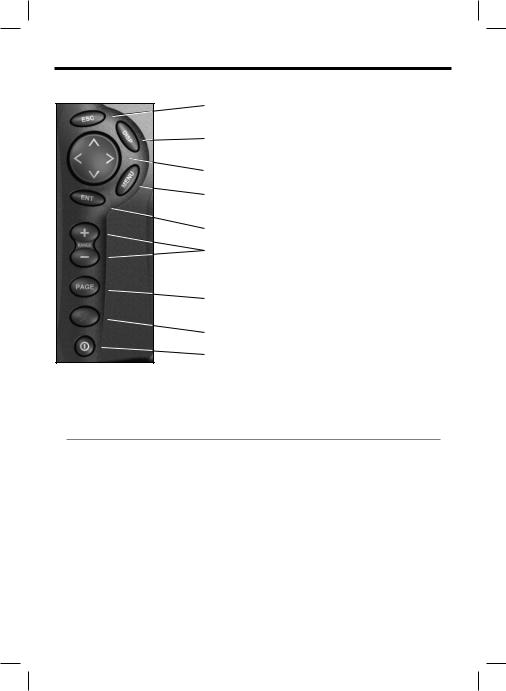
2 Basic Operation
Overview of the keys
In chart mode, centres chart at boat’s position. Go back to an earlier menu or display.
Show a menu of the main displays. To go to a display, select it from the menu (see section 2-7).
Cursor keys, to move the cursor or the selection highlight.
Show a menu of the options for the current display. Press
 again to display the Setup menu (see section 17).
again to display the Setup menu (see section 17).
Start an action or accept a change.
Chart display: Zoom in or out to display di erent areas and detail on the chart.
Sonar display: Change the depth range displayed.
Switch the display to the next in the favorites list (see section 2-7-2)
Man overboard (MOB, see section 2-4).
Turn Explorer on and o (see section 2-2); adjust the backlighting (see section 2-3).
2-1 Using the keys
In this manual:
Press means to push the key for less than a second.
Hold means to hold the key down.
The internal beeper beeps when a key is pressed (to disable or enable the beep, see section 17-1).
Using the menus
Operate the Explorer by selecting items from menus. Items can be submenus, commands or data.
Selecting a submenu
A after a menu item indicates a submenu, for example Chart
after a menu item indicates a submenu, for example Chart  . Press
. Press  or
or  to move the highlight to the submenu, then press
to move the highlight to the submenu, then press  .
.
Starting a command
Press  or
or  to move the highlight to the command, for example Goto cursor, then press
to move the highlight to the command, for example Goto cursor, then press
 .
.
Changing data
First press  or
or  to move the highlight to the data to change, then:
to move the highlight to the data to change, then:
10 |
Northstar Explorer 650 Installation and Operation Manual |
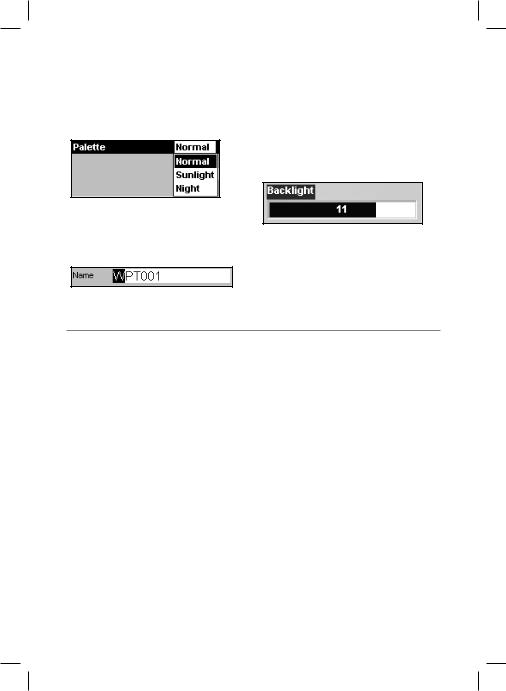
aTo change a tick box
 means On or Yes
means On or Yes
 means Off or No.
means Off or No.
Press  or
or  to change the tick box.
to change the tick box.
bTo select an option
1Press  to display the menu of options.
to display the menu of options.
2Press  or
or  to move the highlight to the option you want, then press
to move the highlight to the option you want, then press  .
.
cTo change a name or number:
1Press  to display the name or number:
to display the name or number:
2Press  or
or  to select a letter or digit to change. Press
to select a letter or digit to change. Press  or
or  to change the letter or digit.
to change the letter or digit.
Repeat this to change other letters or numbers.
3Press  to accept the new value. Or press
to accept the new value. Or press  to ignore the changes.
to ignore the changes.
d To change a slider value
Press  to decrease the value or
to decrease the value or  to increase the value.
to increase the value.
2-2 Turning on and off / auto power
Turning on manually |
Auto power |
If the Explorer is not wired for auto power, press  to turn the unit on. If necessary, adjust the display to be easy to read (see section 2-3).
to turn the unit on. If necessary, adjust the display to be easy to read (see section 2-3).
Note: If the Explorer is not wired for auto power then the Explorer does not record engine hours and might not record fuel consumption (see section 18-4).
Turning off manually
If the Explorer is not wired for auto power or if the ignition switch is off, hold down  until the display turns off.
until the display turns off.
If the Explorer is wired for auto power (see section 18-4), then:
•The Explorer automatically turns on when you turn the boat’s ignition switch on.
•You can not turn the Explorer off while the ignition switch is on.
•If Auto power off (see section 17-1) is  , the Explorer automatically turns off when you turn the boat’s ignition switch off.
, the Explorer automatically turns off when you turn the boat’s ignition switch off.
•If Auto power off (see section 17-1) is  , the Explorer stays on when you turn the boat’s ignition switch off. You can now turn the Explorer off manually.
, the Explorer stays on when you turn the boat’s ignition switch off. You can now turn the Explorer off manually.
Northstar Explorer 650 Installation and Operation Manual |
11 |
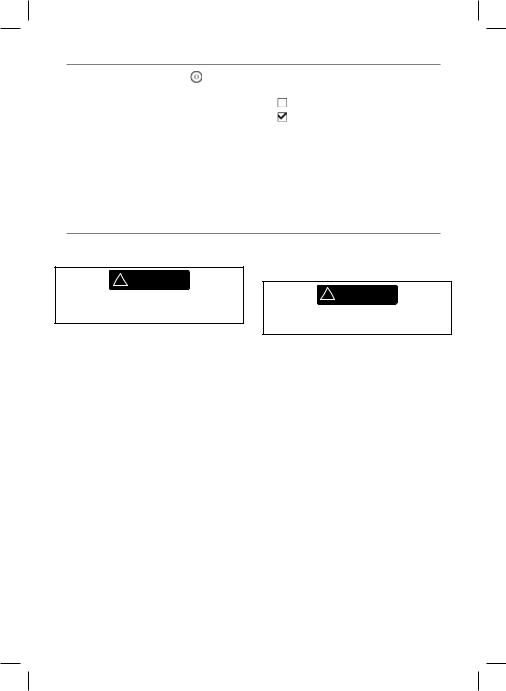
2-3 Backlight and night mode
To go to the Backlight display, press |
briefly. |
Night mode |
Backlight |
|
Night mode sets the palette for all displays. |
|
|
The display and keys are backlit. To change the backlight level, highlight select Backlight, then press
select Backlight, then press  to dim or
to dim or  to brighten.
to brighten.
When you have finished, press 
 Tip: Press
Tip: Press  twice to give the brightest screen, with maximum backlight and Night mode off.
twice to give the brightest screen, with maximum backlight and Night mode off.
Normal palette, for daytime
A palette optimised for night time.
To change mode, hilight Night mode, then press  or
or  . To change only the chart palette,
. To change only the chart palette,
see section 17-2.
2-4 Man overboard (MOB)
The MOB feature saves the boat’s position and then navigates back to this point.
! WARNING
MOB will not work if the Explorer does not have a GPS fix.
1Press  .
.
The Explorer stores the boat’s position as a waypoint called MOB.
2The Explorer changes to the chart display, with the MOB waypoint at the centre of the chart.
The chart zooms in for accurate navigation. If the chart can not show the required small scale, the Explorer changes to plotter mode (a white display with crosshatching and no chart details, see section 17-2).
3The Explorer sets the MOB waypoint to be the destination to navigate to.
If the NMEA output (autopilot) is off (see section 17-10) use the Explorer to manually navigate to the destination MOB waypoint (see sections 3-1-1 and 3-1-2).
If the NMEA output (autopilot) is on, the Explorer asks if the autopilot is active. Select:
No: Use the Explorer to manually navigate to the destination MOB waypoint (see sections 3-1-1 and 3-1-2).
Yes: The Explorer asks if the boat is to go to the MOB waypoint.
Select:
Yes: to immediately start navigating to the MOB waypoint.
! WARNING
This might result in a sudden and dangerous turn.
No: disengage the autopilot; then use the Explorer to manually navigate to the destination MOB waypoint (see sections 3-1-1 and 3-1-2).
To cancel MOB or set another MOB
1 Press  again to display a menu.
again to display a menu.
2Select an option from the menu.
 Tip: The MOB waypoint remains on the chart after the MOB has been cancelled. To delete the MOB waypoint, see section 5-2-5.
Tip: The MOB waypoint remains on the chart after the MOB has been cancelled. To delete the MOB waypoint, see section 5-2-5.
12 |
Northstar Explorer 650 Installation and Operation Manual |
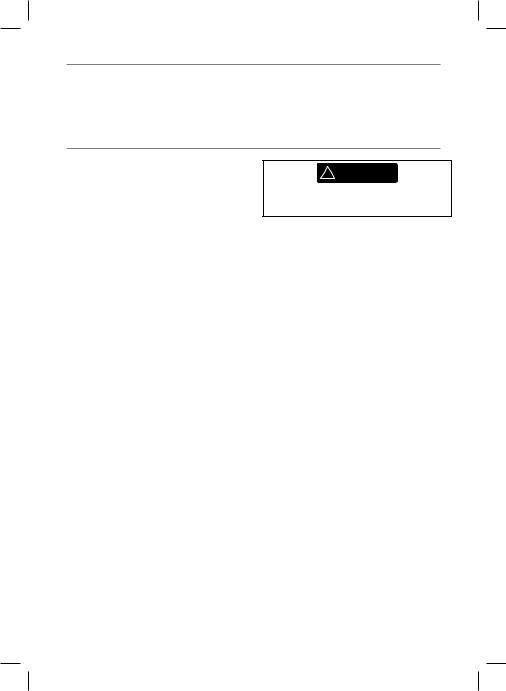
2-5 Alarms
When the Explorer detects an alarm condition, it displays a warning message on the display, the internal beeper sounds and any external beepers or lights operate.
Press  to clear the alarm. The alarm will sound again if the alarm condition occurs again.
to clear the alarm. The alarm will sound again if the alarm condition occurs again.
The Explorer has user settable alarms (see section 17-8).
2-6 Simulate mode
In Simulate mode, the Explorer ignores data from the GPS antenna and other transducers and
sensors and the Explorer generates this data itself. Otherwise, the Explorer functions normally.
There are two simulate modes:
•Normal: Allows a user to become familiar with the Explorer off the water.
! WARNING
Never have Simulate mode on when the Explorer is navigating on the water.
•Demo: Simulates a boat moving along a route and automatically displays different Explorer functions.
To start and stop Simulate mode, and for more information, see section 17-14. In simulate mode, Simulate or Demo flashes at the bottom of the display.
Northstar Explorer 650 Installation and Operation Manual |
13 |
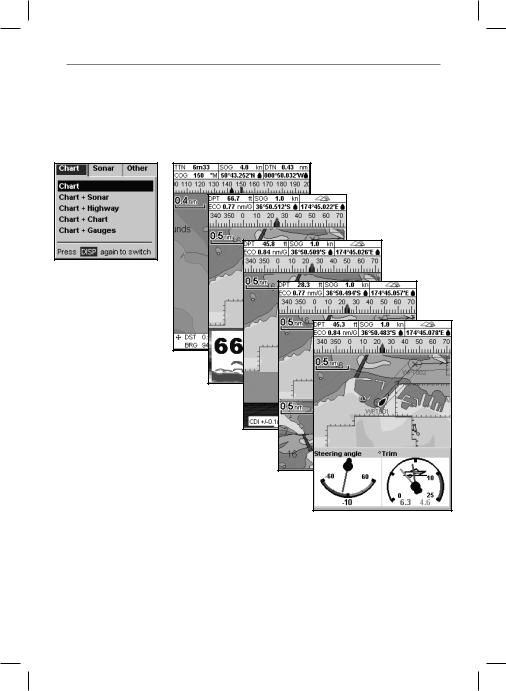
2-7 The main displays
To go to a display, press  , press
, press  or
or  to select the type of display to show, press
to select the type of display to show, press  or
or  to select the display from the list, then press
to select the display from the list, then press  .
.
Chart menu and displays
The available displays depend on the optional sensors and instruments that are installed (see section 1-1).
Note
The sonar displays require sonar to be installed.
14 |
Northstar Explorer 650 Installation and Operation Manual |
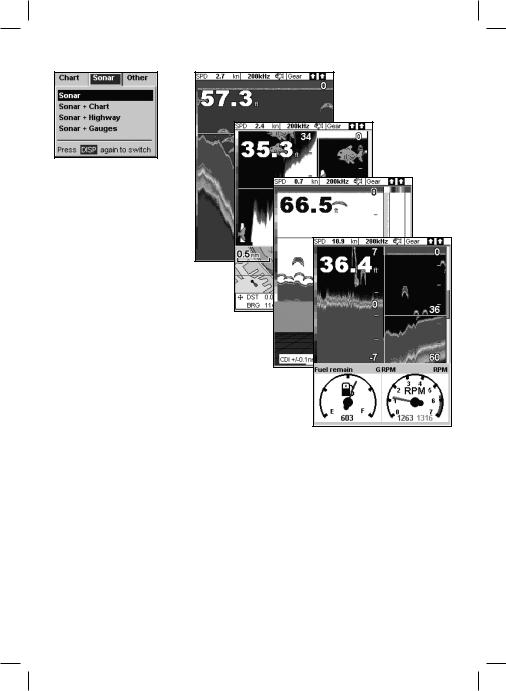
Sonar menu and displays
Note
Press  to go from an Other display back to your last chart or sonar display.
to go from an Other display back to your last chart or sonar display.
The sonar displays require sonar to be installed.
SmartCraft menu and displays
The SmartCraft displays require a SmartCraft system to be installed. For information on using SmartCraft, see the SmartCraft Gateway Installation and Operation Manual.
Note
Press  to go from a SmartCraft display back to your last chart or sonar display.
to go from a SmartCraft display back to your last chart or sonar display.
Northstar Explorer 650 Installation and Operation Manual |
15 |
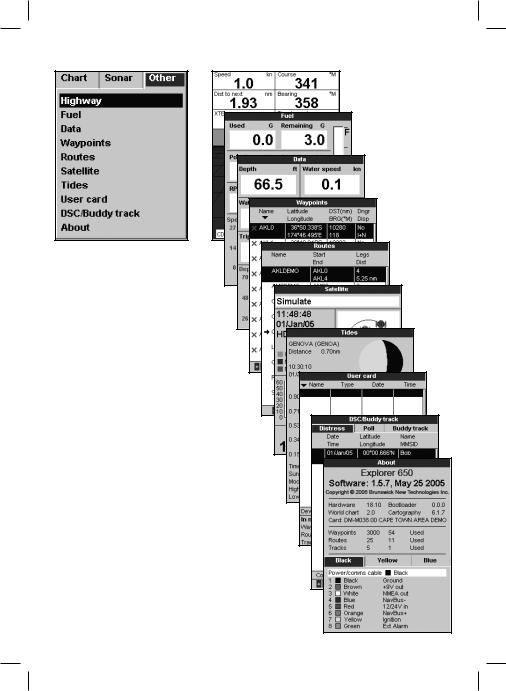
Other menu and displays
Note
Press  to go from an Other display back to your last chart or sonar display.
to go from an Other display back to your last chart or sonar display.
The DSC/Buddy track display requires a VHF radio to be installed.
16 |
Northstar Explorer 650 Installation and Operation Manual |
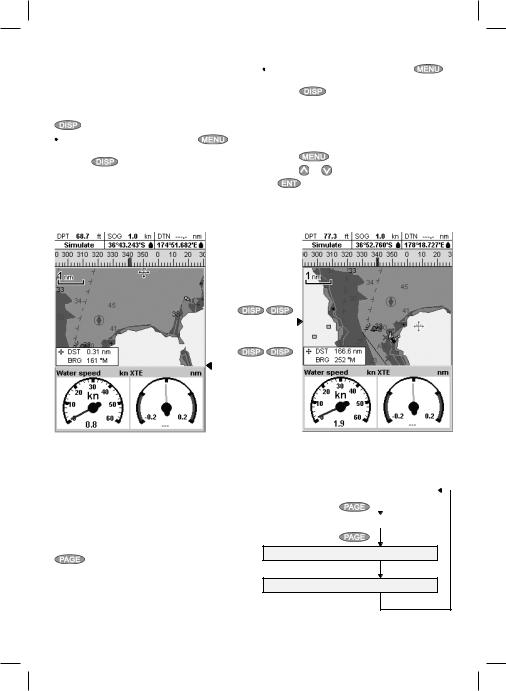
2-7-1 Dual displays
The Explorer can show two displays at once, for |
|
If Gauges is the active display: press |
||||||||||
example Chart + Gauges. One of the displays, |
|
to display the options for Gauges; |
||||||||||
called the active display, has a yellow border and |
|
press |
|
|
twice to make Chart the |
|||||||
is controlled by the user (Highway can not be the |
|
active display. |
||||||||||
active display). To change the active display, press |
Note: Split ratio of chart or sonar and gauges |
|||||||||||
twice. For example: |
|
|
||||||||||
|
|
|
can not be changed. |
|||||||||
|
|
|
|
|
||||||||
If Chart is the active display: press |
|
to |
To adjust the relative sizes of the two displays: |
|||||||||
display the options for Chart; |
|
|
||||||||||
|
|
1 |
Press |
|
|
and select Split ratio. |
||||||
press |
twice to make Gauges the active |
|
|
|||||||||
2 |
Press |
|
or |
to adjust the sizes, then press |
||||||||
display. |
|
|
|
. |
||||||||
|
|
|
|
|
|
|
|
|
|
|
|
|
|
Chart display is |
|
|
|
|
|
|
|
Chart display is |
|||
|
active |
|
|
|
|
|
|
|
not active |
|||
|
|
|
Yellow border |
|
|
|
|
|
|
|||
|
|
|
|
|
|
|
|
|
||||
|
|
|
|
|
|
|
|
|
||||
|
|
Press |
|
|
|
|
|
|
|
|
|
|
|
|
|
|
|
|
|
|
|
|
|
|
|
|
|
Press |
|
|
|
|
|
|
|
|
|
|
|
|
|
|
|
|
|
|
|
|
|
||
|
|
|
Yellow border |
|
|
|
|
|
|
|
||
|
|
|
|
|
|
|
|
|
||||
|
|
|
|
|
|
|
|
|
|
|
|
|
|
Gauges display |
|
|
|
|
|
|
|
Gauges display is |
|||
|
is not active |
|
|
|
|
|
|
|
active |
|||
2-7-2 Favorite displays |
|
|
|
|
|
|
|
|
|
|
|
|
|
|
|
|
|
|
Chart, first favorite |
|
|
||||
The Explorer has a list of commonly used displays, |
|
|
|
|
|
|
||||||
|
|
|
|
Press |
|
|
|
|||||
called favorite displays. There can be up to six |
|
|
|
|
|
|
|
|||||
|
|
|
|
|
|
|
|
|
||||
favorite displays and three can be set by the user |
|
|
|
Sonar, second favorite |
|
|||||||
(see section 17-13). |
|
|
|
|
|
|
Press |
|||||
|
|
|
|
|
|
|
|
|||||
To change the display to the next favorite, press
Chart + sonar, third favorite
. For example, with four favorites:
Press 
Fourth favorite display
Press 
Northstar Explorer 650 Installation and Operation Manual |
17 |
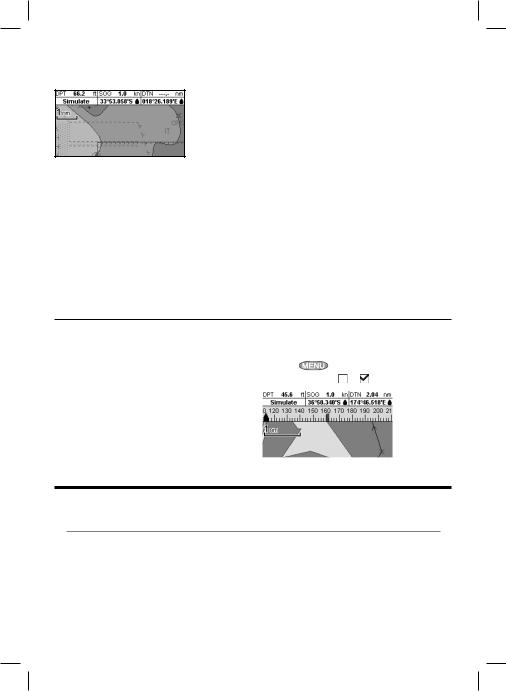
2-7-3 Data header
The chart, sonar and highway displays can show data at the top of the display.
The data header for each display can be different. To change the data header for a display:
1Go to the display, press  and select Data header.
and select Data header.
2To turn the data header off or on:
i Select Data.
ii Select  or
or  .
.
3To choose the size of the data: i Select Size.
ii Select Small, Medium or Large.
4To change the data displayed: i Select Data setup.
iiChange a data field:
a Press the cursor keys to highlight the field.
b Press  to display a menu of data items.
to display a menu of data items.
c Select a data item that is available on your system or select None to leave the field empty.
iiiRepeat the above step to set the other data fields.
 Tip: If all fields in a line are None then the line will not be displayed and the data header will take less space on the display.
Tip: If all fields in a line are None then the line will not be displayed and the data header will take less space on the display.
5Press  to return to the display.
to return to the display.
2-7-4 Compass
The chart, sonar and highway displays can show a |
To turn the compass off or on: |
||||
compass at the top of the display. |
1 |
Press |
and select Data header. |
||
|
|||||
The compass always shows the boat’s course over |
2 |
Set Compass to or . |
|||
ground (COG), a red symbol in the middle. When |
|||||
|
|
|
|
||
the boat is navigating to a point, the compass |
|
|
|
|
|
also shows bearing to the destination (BRG), a |
|
|
|
|
|
black symbol. |
|
|
|
|
|
In this example, COG is 161° and BRG is 114°. |
|
|
|
|
|
|
|
|
|
|
|
3 Navigation: Chart
The chart display shows the chart, the boat’s position course and navigation data.
3-1 Introduction to navigating
The Explorer has two ways of navigating, going straight to a point or following a route.
18 |
Northstar Explorer 650 Installation and Operation Manual |
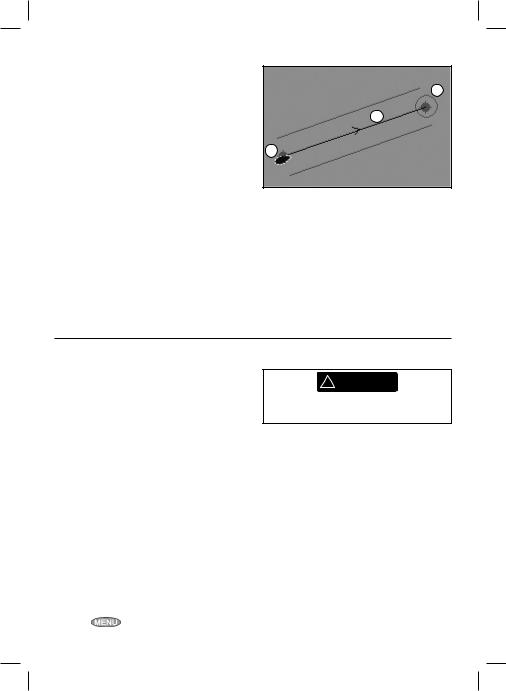
3-1-1 Navigating to a point
When the Explorer is navigating to a point, the chart and highway displays show navigation data:
AThe boat position .
.
B The destination point marked with a circle.
CThe boat’s plotted course to the destination.
DTwo CDI lines, parallel to the boat’s plotted course, which indicate the maximum expected deviation from the plotted course.
For more information, see appendix C.
If the Explorer is connected to an autopilot, the Explorer will send data to the autopilot to steer the boat to the destination. Start the autopilot before starting to navigate to the point.
If the Explorer has no autopilot, steer the boat manually:
ause the boat position and destination on the chart or highway displays
bor use navigation data displayed on the data header (see section 2-7-3)
cor use COG and BRG on the compass (see section 2-7-4).
B
C
A
Note:
1If the XTE alarm is enabled, an alarm will sound if the boat deviates too much from its intended course (see section 17-8).
2If the arrival radius alarm is enabled, then an alarm will sound to show that the boat has reached the destination
(see section 17-8).
3-1-2 Going to a waypoint or to a point on the chart
A waypoint is a position that you can set on the Explorer chart, for example a fishing spot or a point on a route (see section 5).
Going to a waypoint from the chart display
1Go to the chart display.
! WARNING
Make sure the course does not pass over land or dangerous waters.
2Move the cursor to the waypoint: either use the cursor keys or use Find (see section 3-2-5).
3Press  and select Goto.
and select Goto.
Going to a waypoint from the waypoints display
1Go to the waypoints display.
2Press  or
or  to highlight the waypoint to go to.
to highlight the waypoint to go to.
3Press  and select Goto.
and select Goto.
Going to a point on the chart
1Switch to a chart display.
2Move the cursor to the destination point: either use the cursor keys or use Find (see section 3-2-5).
3 Press |
and select Goto cursor. |
Navigating
The Explorer navigates to the point as described in section 3-1-1.
Cancelling navigating
Go to a Chart display, press  and select
and select
Cancel goto.
 Tip: Before starting, create waypoints at points of interest. Create a waypoint at the start of the trip for you to navigate back to (see section 5-2-1).
Tip: Before starting, create waypoints at points of interest. Create a waypoint at the start of the trip for you to navigate back to (see section 5-2-1).
Northstar Explorer 650 Installation and Operation Manual |
19 |
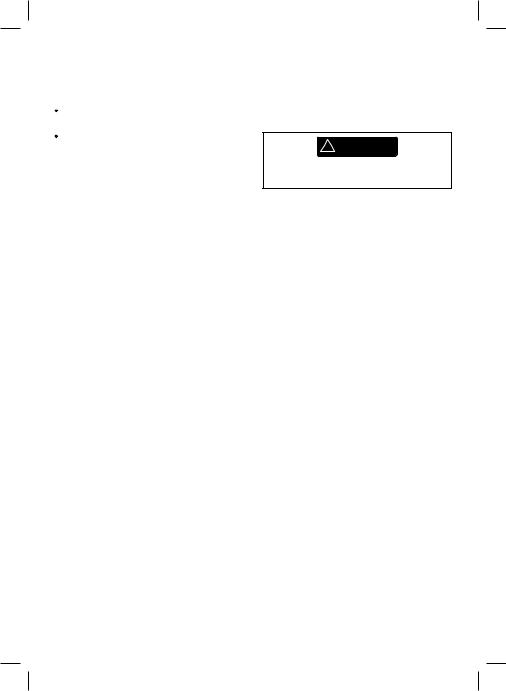
3-1-3 Following a route
Preparing
A route is a list of waypoints that the boat can follow (see section 6).
To create waypoints before creating the route, see section 5-2-1.
To create a route, see section 6-2-1.
Starting a route from the chart display:
1Go to the chart display.
2Press  and select Start Route
and select Start Route
3Press  or
or  to highlight the route to follow. Press
to highlight the route to follow. Press  .
.
4The Explorer asks for the direction to traverse the route.
Select Forward (the order the route was created) or Reverse.
5The Explorer displays the chart with the route marked and starts navigating from the start of the route.
Starting a route from the routes display:
1Go to the routes display.
2Then follow step 3 as in starting a route from the chart display above.
Navigating
The Explorer navigates to each waypoint on the route in turn as described in section 3-1-1.
The Explorer stops navigating to the waypoint at the end of the current leg and starts the next leg of the route:
awhen the boat comes within 0.025 nm of the waypoint
b or when the boat passes the waypoint
cor if you skip the waypoint.
Skipping a waypoint
To skip a waypoint, go to a chart display, press  and select Skip. The Explorer starts navigating straight towards the next waypoint on the route.
and select Skip. The Explorer starts navigating straight towards the next waypoint on the route.
! WARNING
Skipping a waypoint with the autopilot on might result in a sudden course change.
Cancelling a route
When the boat has reached the final waypoint, or to stop the boat following the route at any time, cancel the route. Go to a chart display, press  and select Cancel route.
and select Cancel route.
20 |
Northstar Explorer 650 Installation and Operation Manual |
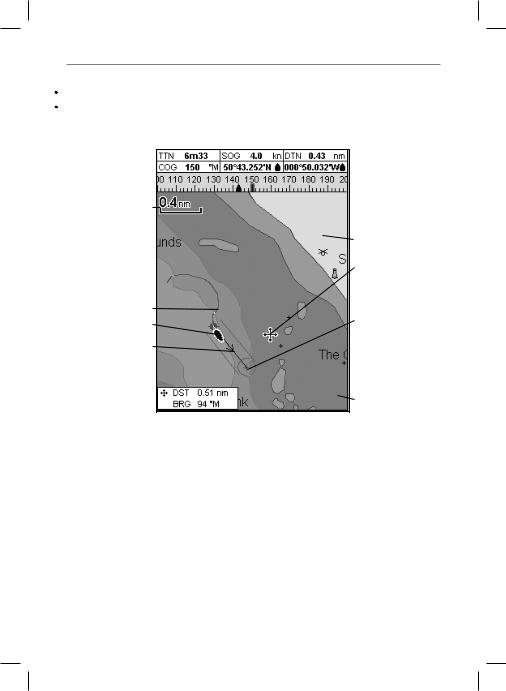
3-2 Chart display
To go to the Chart display:
either press  one or more times until the chart is displayed or press
one or more times until the chart is displayed or press  , select Chart, then select Chart.
, select Chart, then select Chart.
A typical chart display shows:
A
C
E
D
F
G
AData header. To turn the data off or on or to change what data is displayed (see section 2-7-3)
B Compass (see section 2-7-4)
C Chart scale (see section 3-2-3)
D Boat position (see section 3-2-1)
EBoat track (see section 3-5)
FBoat course and CDI lines (see Appendix C, CDI). The boat is going to the waypoint called FISH6
G Distance and bearing of cursor from boat
H Land
B
H
J
K
I
Note:
To change the types of information displayed on the chart, see section 17-2.
To change to a perspective view of the chart, see section 3-2-6.
ISea
JThe cursor (see section 3-2-1)
KA typical waypoint (see section 5)
Northstar Explorer 650 Installation and Operation Manual |
21 |
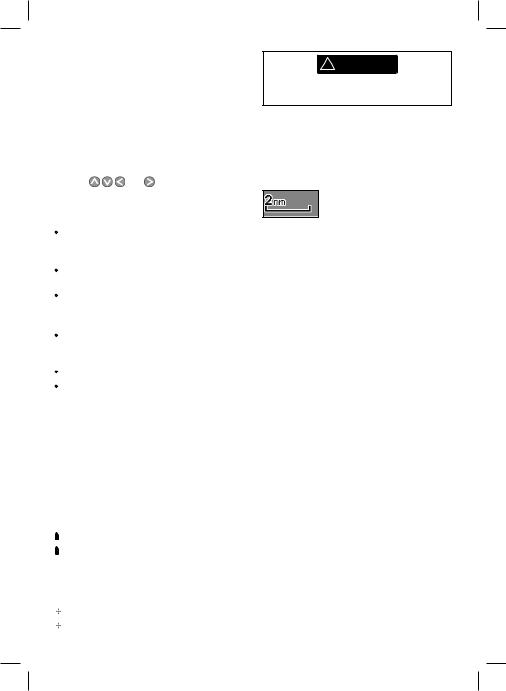
3-2-1 Chart modes
The Chart has two modes:
Centre on boat mode
To switch to centre on boat mode in the chart display, press  . The boat
. The boat is at the centre of the chart. As the boat moves through the water, the chart automatically scrolls to keep the boat in the centre of the chart. The cursor (see below) is turned off.
is at the centre of the chart. As the boat moves through the water, the chart automatically scrolls to keep the boat in the centre of the chart. The cursor (see below) is turned off.
Cursor mode |
|
The keys |
and are called cursor keys. |
To switch to cursor mode in the chart display, |
|
hold down a cursor key. The cursor  appears and moves away from the boat:
appears and moves away from the boat:
Press the key which points in the direction that the cursor will move, for example press
 to move the cursor down.
to move the cursor down.
Press midway between two of the cursor keys to make the cursor move diagonally.
Hold a cursor key down to make the cursor move continuously across the display.
In Cursor mode:
The distance ( DST) and bearing (
DST) and bearing ( BRG) of the cursor from the boat are displayed at the bottom corner of the display.
BRG) of the cursor from the boat are displayed at the bottom corner of the display.
The chart does not scroll as the boat moves.
If the cursor reaches the edge of the display, the chart will scroll.
For example, hold down  to move the cursor to the right side of the display and the chart will scroll to the left.
to move the cursor to the right side of the display and the chart will scroll to the left.
3-2-2 Latitude and longitude
Latitude and longitude can be displayed in the data header. The display is degrees and minutes to three decimal places, about 2 m (6
ft) resolution. Normally the position is the boat’s position, and the latitude and longitude has a boat symbol to show this:
36° 29.637’ N or S |
Latitude |
175° 09.165’ E or W |
Longitude |
If the cursor has been moved in the last ten seconds, then the position is the cursor’s position, and the latitude and longitude has a cursor symbol to show this:
36° 29.841’ N or S |
Latitude |
175° 09.012’ E or W |
Longitude |
! WARNING
When reading the boat position, make sure the position is not the cursor position.
3-2-3 Chart scale
Press  to zoom in and display a smaller area of the chart in more detail. Press
to zoom in and display a smaller area of the chart in more detail. Press  to zoom out and display a bigger area in less detail.
to zoom out and display a bigger area in less detail.
The chart scale is displayed at the top left of the chart:
3-2-4 Chart symbols and information
The chart shows many kinds of symbols, such as waypoints, ports, marinas, buoys and beacons. If necessary, press or  or
or  to choose a chart scale where the symbol is displayed.
to choose a chart scale where the symbol is displayed.
To see stored information about a symbol:
1Either move the cursor to the symbol on the chart and wait two seconds
or use Find to move the cursor to a symbol for a port or service (see section 3-2-5).
2A window appears at the bottom of the display with some information about the symbol.
3To see more detail about a symbol or a list of associated items for the symbol, press  :
:
i Select an item to display. If there are more
items than will fit on the display, press  or
or  to scroll up or down.
to scroll up or down.
Select a camera icon to display a photo
of the item. If the photo is too big to fit on the display, press  ,
,  ,
,  or
or  to scroll the photo.
to scroll the photo.
Select Tide Station to display a tide chart for the position (see section 13).
iiSelect other items or press  to return to the chart.
to return to the chart.
To see stored information about nearby symbols press  and select Chart info. Then follow step 3 above.
and select Chart info. Then follow step 3 above.
22 |
Northstar Explorer 650 Installation and Operation Manual |
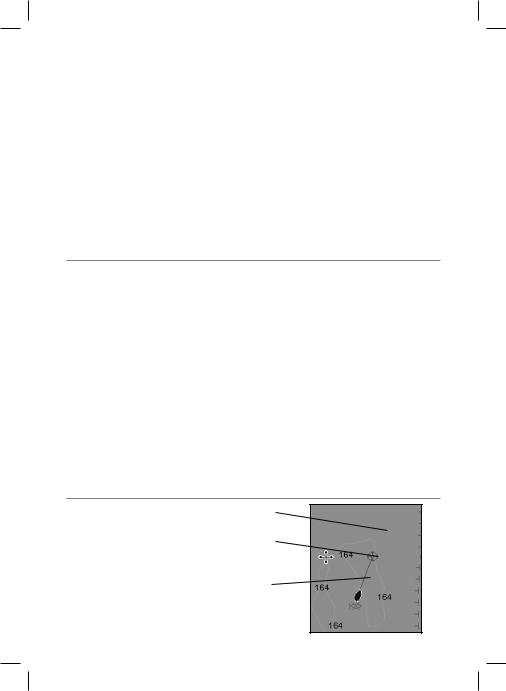
3-2-5 Finding a chart symbol
To find and display a chart symbol:
1Press  and select Find.
and select Find.
2Select the type of symbol: Waypoints, Routes, Ports by name, Ports & services, or Tide stations.
3For Ports & services: select the type of service to find.
For Ports by name: press  ,
,  ,
,  or
or  to
to
enter a name or letters contained in the port name, then press  .
.
4A list of items is displayed. If there are more items than will fit on the display, press  or
or  to page up and down.
to page up and down.
For Ports by name: to search for a different port name, press  . change the name, then press
. change the name, then press  .
.
5Select the item and press  . The chart display changes to show the item in the middle of the display.
. The chart display changes to show the item in the middle of the display.
To see stored information about the item, press  (see section 3-2-4).
(see section 3-2-4).
3-2-6 Perspective view
Perspective view shows the chart from an angle instead of from straight above. To turn
perspective view on or off, press  and set
and set
Perspective to  or
or  .
.
3-3 Distance and bearing calculator
The distance and bearing calculator can plot a course of one or several legs and show the bearing and length of each leg, as well as the
total distance along the course. The completed course can be converted into a route.
To use the distance and bearing calculator:
1Select the Chart window. Press  and select Distance.
and select Distance.
2Move the cursor to the start of the first leg. It
does not matter if this point is a waypoint or not. Press  .
.
3To add a leg to the course, move the cursor to the end of the leg. It does not matter if this point is a waypoint or not. The display shows the bearing and length of the leg, as well
as the total distance along the course. Press  .
.
4To remove the last leg from the course, press  and select Remove.
and select Remove.
5Repeat the above two steps to enter the whole course.
6To save the new course as a route, press  and select Save. This also saves any new points on the course as new waypoints, with default names. If necessary, edit the route later (see section 6-2-2) and edit any new waypoints later (see section 5-2-3).
and select Save. This also saves any new points on the course as new waypoints, with default names. If necessary, edit the route later (see section 6-2-2) and edit any new waypoints later (see section 5-2-3).
7Finally, press  to return to the chart display.
to return to the chart display.
3-4 Projected course
If Projected course is turned on, then the Explorer |
A |
||
will display the projected position based on the |
|
||
course over ground (COG), speed and a specified |
B |
||
time. To turn Projected course on and off and to |
|||
|
|||
set the time, see section 17-2. |
|
||
A |
Projected position |
C |
|
B |
Boat’s projected course |
|
|
CBoat position
Northstar Explorer 650 Installation and Operation Manual |
23 |
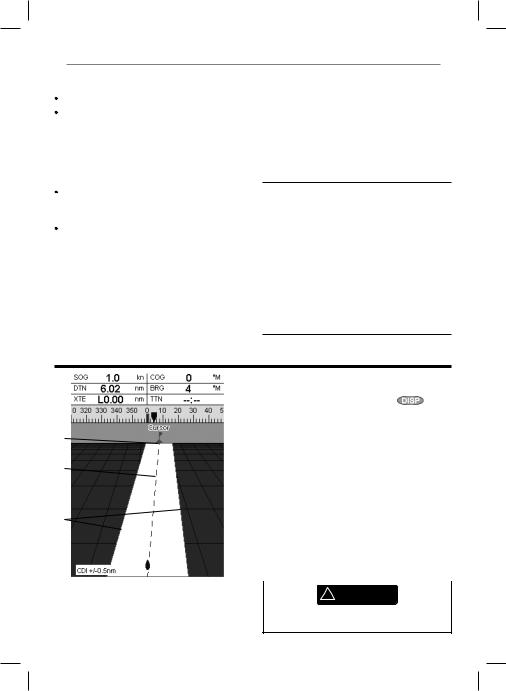
3-5 Tracks and tracking
Tracking records the boat’s position to memory at regular intervals, which can be:
Time intervals.
Or distance intervals.
The track of where the boat has been can be displayed on the chart. The Explorer can display one track while recording another.
To work with tracks, see section 17-6.
The Explorer can store five tracks:
Track 1 can hold up to 2000 points and is intended to record the normal progress of the boat.
Tracks 2, 3, 4 and 5 can hold up to 500 points each and are intended to record sections to be retraced accurately, for example entering a river mouth.
 Tip: Record a reference tracks and then use the track to help navigate the same trip later. For example, record a reference track as you leave harbour. Then if you return to harbour and visibility is poor, select the chart and navigate manually along the reference track back into
Tip: Record a reference tracks and then use the track to help navigate the same trip later. For example, record a reference track as you leave harbour. Then if you return to harbour and visibility is poor, select the chart and navigate manually along the reference track back into
the harbour. Record reference tracks in good conditions.
When recording is on and the track becomes full then recording continues and the oldest points in the track are deleted. The maximum length of a track depends on the selected track interval: a small interval will give a shorter, more detailed track and a long interval will give a longer, less detailed track, as shown in these examples:
Time intervals
Interval |
Track 1 |
Track 2, 3, 4 or 5 |
||
1 sec |
33 |
minutes |
8 |
minutes |
10 sec |
5.5 |
hours |
1.4 |
hours |
1 min |
33 |
hours |
8 |
hours |
Distance intervals |
|
|
|
|
Interval |
Track 1 |
Track 2, 3, 4 or 5 |
||
|
|
|
|
|
0.01 |
20 |
|
5 |
|
1 |
2,000 |
|
500 |
|
10 |
20,000 |
|
5,000 |
|
The track lengths are in the current distance units, for example nm.
4 Navigation: Highway display
A |
|
|
|
The highway display has a bird’s eye view of the |
||
|
|
|
boat’s course to a destination: |
|
||
|
|
|
|
To go to the Highway display, press |
, select |
|
B |
|
|
|
Other, then select Highway. |
|
|
|
|
|
|
The highway display shows: |
|
|
C |
|
|
|
A |
Optional data header (see section 2-7-3) |
|
|
|
|
|
|||
|
|
|
|
B |
Optional compass (see section 2-7-4) |
|
D |
|
|
|
C |
Destination waypoint |
|
|
|
|
|
D |
Boat’s plotted course to destination |
|
|
|
|
|
E |
CDI lines, parallel to the boat’s plotted course |
|
E |
|
|
|
|
(see Appendix C, CDI). The CDI lines are like a |
|
|
|
|
|
highway over the water where the boat will |
||
|
|
|
|
|
move. |
|
|
|
|
|
F |
CDI scale |
|
|
|
|
|
G |
The boat position is at the bottom, centre of |
|
|
|
|
|
|
the display. |
|
|
F |
G |
|
|
|
|
|
|
! WARNING |
|
|||
|
|
|
|
|
|
|
The highway display does not show land, dangerous waters or chart symbols.
24 |
Northstar Explorer 650 Installation and Operation Manual |
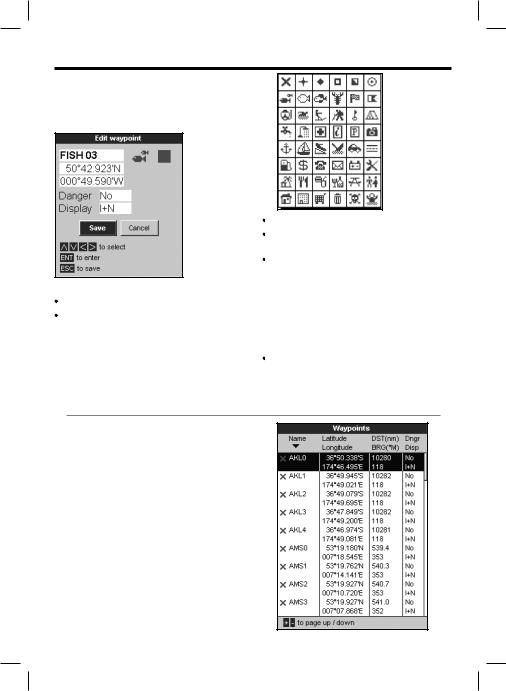
5 Navigation: Waypoints
A waypoint is a position that you can set on the Explorer chart, for example a fishing spot or a point on a route. The Explorer can have up to 3000 waypoints. A waypoint can be created, changed or deleted.
A waypoint has:
A name (up to eight characters).
An icon showing what kind of waypoint it is. The available icons are:
Aposition.
Acolor for the waypoint symbol and name on the chart.
Atype:
Normal: A normal waypoint can be navigated to or included in a route.
Danger: A danger waypoint is a point to avoid. If the boat comes within the danger radius of a danger waypoint the unit can sound an alarm
(see section 17-8).
A display option:
Controls how the waypoint is displayed on the chart (see section 17-2):
5-1 Waypoints display
To go to the waypoints display, press  , select Other, then select Waypoints.
, select Other, then select Waypoints.
The waypoints display is a list of the waypoints that have been entered, each with waypoint symbol, name, latitude and longitude, distance and bearing from the boat, type and display option.
If there are more waypoints than will fit on the display, press  or
or  to scroll up or down a page at a time.
to scroll up or down a page at a time.
Northstar Explorer 650 Installation and Operation Manual |
25 |
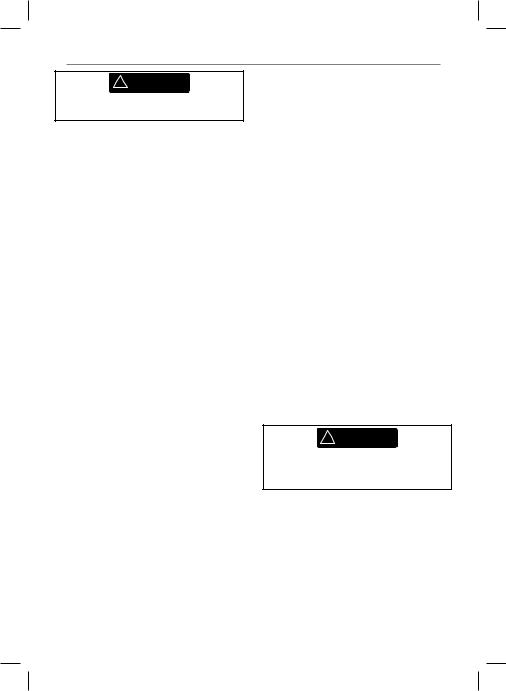
5-2 Managing waypoints
! WARNING
Do not create a navigation waypoint on land or in dangerous water.
5-2-1 Creating a new waypoint
Creating and editing a new waypoint from the chart display
1To create a waypoint at the boat position, press ESC to switch the chart to centre on boat mode.
Or, to create a waypoint at a different point, move the cursor to that point on the chart.
2Press  .
.
3A new waypoint, with the default name and data is created.
4Change the waypoint data if necessary (see section 5-2-7).
Creating a new waypoint from the waypoints display
1In the waypoints display, press  and select Create.
and select Create.
2A new waypoint, with a default name and data, is created at the boat position.
3Change the waypoint data if necessary (see section 5-2-7).
Note: Waypoints can also be created when a route is created (see section 6-2-1).
5-2-2 Moving a waypoint
Moving a waypoint from the chart display
1In the chart display, move the cursor to the waypoint to move.
2Press  and select Move.
and select Move.
3Move the cursor to the new position and press  .
.
Moving a waypoint from the waypoints display
To move a waypoint from the waypoints display, edit the waypoint (see section 5-2-3) and change the latitude and longitude.
5-2-3 Editing a waypoint
Editing a waypoint from the chart display
1In the chart display, move the cursor to the waypoint to edit.
2When the waypoint data is displayed, press  .
.
3Change the waypoint data (see section 5-2-7).
Editing a waypoint from the waypoints display
1In the waypoints display, press  or
or  to highlight the waypoint to edit. Press
to highlight the waypoint to edit. Press  and select Edit.
and select Edit.
2Change the waypoint data (see section 5-2-7).
5-2-4 Displaying a waypoint on the chart
This goes to the chart display, and shows the selected waypoint at the centre of the display.
1In the waypoints display, press  or
or  to highlight the waypoint to display. Press
to highlight the waypoint to display. Press  and select Display.
and select Display.
Or, in the Chart display, press  , select Find, then select Waypoints. Select a waypoint from the list.
, select Find, then select Waypoints. Select a waypoint from the list.
2The Explorer switches to the chart display, with the selected waypoint at the centre of the chart.
5-2-5 Deleting a waypoint
A waypoint can not be deleted if the boat is navigating to it or if the waypoint is used in more than one route. A waypoint that is used in one route can be deleted.
! WARNING
When a waypoint is deleted from a route, check that the changed route does not cross land or dangerous waters.
Deleting a waypoint from the chart display
1In the chart display, move the cursor to the waypoint to delete.
2 Press  and select Delete.
and select Delete.
3Select Yes to confirm.
Deleting a waypoint from the waypoints display
1In the waypoints display, press  or
or  to highlight the waypoint to delete. Press
to highlight the waypoint to delete. Press  and select Delete.
and select Delete.
2Select Yes to confirm.
26 |
Northstar Explorer 650 Installation and Operation Manual |
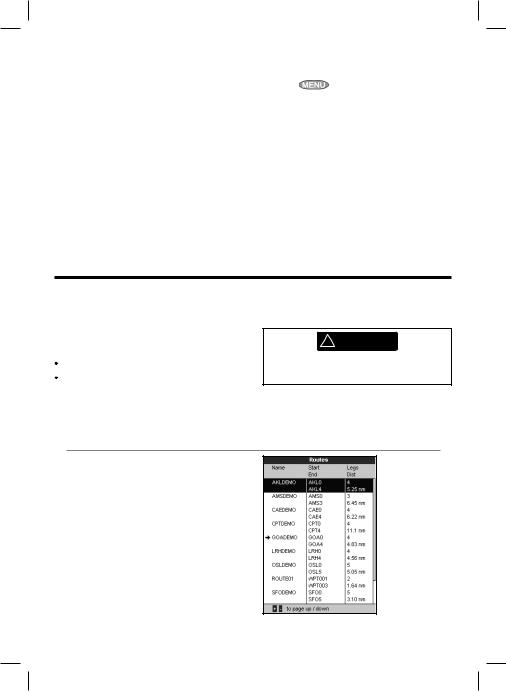
5-2-6 Deleting all waypoints
1In the waypoints display and press  and select Delete all.
and select Delete all.
2Select Yes to confirm.
5-2-7 Changing a waypoint’s data
To change the waypoint data when it is displayed in a window:
1Select the data to change. Press  .
.
Use the cursor keys to change the data. Press  .
.
2If necessary, repeat the above step to change other data.
3Select Save.
5-2-8 Sort Waypoints
To change how the waypoints list is displayed:
1 Press |
and select Sort by. |
2Select how to display the list:
Name: In alphabetical order by name.
Icon: Grouped by icon type.
Distance: In order of distance from the boat.
An arrow at at the top of a column indicates how the waypoints are sorted.
5-2-9 Navigating to a waypoint
See section 3-1-2.
6 Navigation: Routes
A route is a list of waypoints that the boat can navigate along. Routes can be created, changed and deleted.
The Explorer can have up to 25 routes. Each route can have up to 50 waypoints.
A route can:
Start and stop at the same waypoint .
Include waypoints more than once.
The Explorer can navigate along a route in either direction. Waypoints on the route can be skipped.
Routes are a powerful feature when the Explorer is connected to an autopilot, allowing the vessel to be automatically guided along the route.
! WARNING
Make sure the course does not pass over land or dangerous waters.
6-1 Routes display
The routes display is a list of the routes that have been entered, each with route name, start waypoint, end waypoint, number of legs and total distance.
To go to the routes display, press  , select Other, then select Routes.
, select Other, then select Routes.
If there are more routes than will fit on the display, press  or
or  to scroll up or down a page at a time.
to scroll up or down a page at a time.
Northstar Explorer 650 Installation and Operation Manual |
27 |
